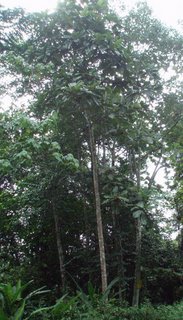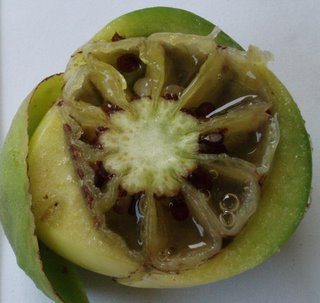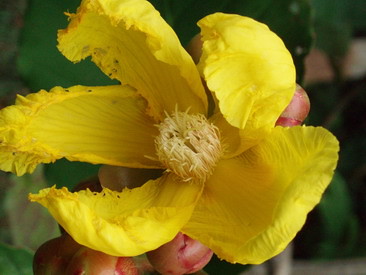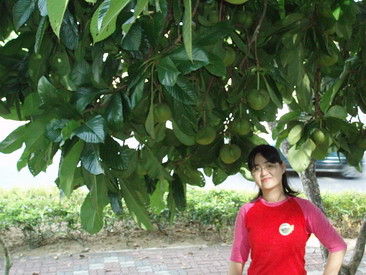Tuesday, October 24, 2006
Wednesday, October 18, 2006
Doing taxonomic work
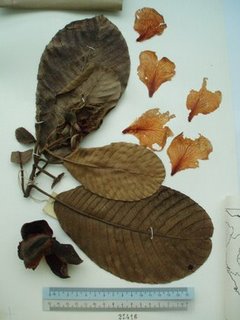
Wednesday, October 11, 2006
Is it Dillenia excelsa?
With that, we venture into the forest in search of Dillenia. True to what the ranger said, we didn’t manage to find any species nearby, so we wandered inner the jungle. We stopped quite often to take a look at the leaves on the top canopy trying to scrutinized whether the leaves description tally with any of the Dillenia species that are expected to occur in Malacca. Most of the leaves that we thought are of some resemblance turned out to be far from it when we got nearer to the tree. After much trial and error and being stung with dozens of mosquitoes, we were really exhausted and almost gave up. Without our realization, almost 3 hours had slipped away. On our way out, a tree caught my eye and my instinct tell me that this might be a tree I’m looking for.
We approached the tree and I started to look at the fallen leaves. The shape, colour, apex, base, petiol, veins and size are very close with the description of Dillenia excelsa. The only thing that doesn’t fit is that the abaxial of the leaves are not really sparsely to densely hairy as described. You can only manage to see few hairs standing apart from each other if scrutinizing the abaxial of the leaves with magnifying glass. To further clarify this species, I tried by comparing the description of the bark. After much consideration, I think it does fit the description. With this comfirmation, I decided to capture the photographs of it. It is really a hard work to capture a nice photo of tall trees with the presence of sunlight glimpses. I can’t even focused on the nearest fresh leaves to capture its’ morphological structure.
Later on, we tried to pluck the nearest leaves to be my boucher specimen. Unfortunately, it’s too high for us to reach (picture above) and we’re unable to find much longer stem to be our pole. After trying for about half an hour, we quit. We only brought back a few dried leaves and manage to find 2 to 3 yellowish green leaves for my anatomical sample. Somehow, I’m still doubtful of this species that I gather as it differs with the herbarium leaves that I observed in UKMB especially the leaf surface. I’m not sure whether it’s due to natural drying leaves with oven dried leaves. I guess I’ll consult En. Shamsul for his opinion as he has better experienced and might be able to settle my doubt.
My First Encounter With Dillenia
From this assignment, I got the opportunity to get to know two species of Dillenia that are very commonly found. The first species is the shrubby simpoh or Dillenia suffruticosa. It is also known as “Simpoh Ayer” by local. I was attracted to it because it had large showy yellow petals (picture below). Besides that, another structure that caught my attention at that time is the reddish seeds from the indehiscent fruits that have a star-like shape. Even till now, I was still fascinated to see it. Although it flowers throughout the year, it is not easy to bump into its’ fruit that is still intact with seeds. Both fruits and petals of flowers of this species fell off by noon. I even found out from an article that the flowers and fruits started to expand early before dawn around 3 a.m and the flowers are in full bloom an hour before sunrise.
The second species of Dillenia that I encounter is Dillenia indica or much famously known as the elephant apple tree. Yes, you’re right! I was fascinated with the fruits of that tree. It’s huge and the first resemblance that flashes in my mind at that moment was the coconut fruit. The fruit is hard and heavy. The ripen fruits are yellowish in colour while the unripen fruits are apple green. Somehow, I didn’t get the chance to cut the fruit at that time but recently, I did it to satisfy my curiosity as well as part of understanding my genus much more. I’m still hunting for its’ flower somehow. My hunger to touch and capture the flower of this species will not be satisfied by just looking at other people photographs. Besides, I’ll only understand the structure of the flower part much better with a specimen on hand. Moreover, the petals are white in colour. Therefore, it’ll be highlighting the tree which has dark green leaves. Below right is my photo with the elephant apple tree taken on 28 August 2006.
Knowing the author of "simpoh"
My father is the breadwinner of my family. He worked as a chief clerk and I honour him very much as he is a very dedicated and trustworthy person. He is a peaceful and caring person. Although he seldom expressed his love directly, we can feel it through his preliminary preparations when we went back home and showers of gifts. My father just retired recently but he still continues his work at his company (Sime Darby) in Sabrang Estate. On the other hand, my mother is a housewife. She is the best cook ever that I known of as she can cook Chinese, Malay, Indian and some western food too. She never gets tired of trying to improve and create new recipes in her cooking. Therefore, it’s surely always a feast when one visited my house. My mother is also a very caring and sweet person and able to handle household chores perfectly.

Currently, I’m pursuing my master in UKM on Plant Systematics. I’m working on my master project, ‘A Taxonomic Revision on the Genus of Dillenia in Peninsular Malaysia’ under the supervision of Prof. Dato’ Dr. Abdul Latiff Mohamad. This is something new to me and I’m still in the process of learning about this genus which is much known as ‘simpoh’ by the locals. Fundamentally, it is not easy to recognize this genus in the forest unless there are inflorescences or one already familiar with trees in the forest. Somehow, I’m very satisfied that I’d encountered five species out of ten species on my fieldworks recently.
